On the 20th of May 2019, the Ugandan government conferred city status upon Gulu, along with four other regional municipalities across the country. Gulu will formally become a city in July 2020. Two weeks after the Ugandan government’s announcement, a workshop was held with senior planning officers from Gulu, as well as international urban design specialists, and academic researchers, to examine the existing processes of urban planning in Gulu (and in Uganda in general), and to explore how these might be further strengthened in the future.


Urban planning for the future Gulu city
© Australian Urban Design Research Centre 2019 Snapshot report
Richard Vokes
Alex Thornton
Raphael Aregu
Julian Bolleter
Anthony Duckworth
Katrien Pype
Tony McBurney
Executive Summary
On the 20th of May 2019, the Ugandan government conferred city status upon Gulu, along with four other regional municipalities across the country (Mbarara, Jinja, Fort Portal and Arua). Gulu will formally become a city in July 2020.
Two weeks after the Ugandan government’s announcement, a workshop was held with senior planning officers from Gulu, as well as international urban design specialists, and academic researchers, to examine the existing processes of urban planning in Gulu (and in Uganda in general), and to explore how these might be further strengthened in the future.
This report – which emerged out of the Gulu workshop –highlights the advantages for Gulu of further emphasising both sustainability, and smart city’ technologies, within their future planning. It particularly highlights how co-design methods –and especially that of the ‘Rapid City’ serious game (which was developed by the Australian Urban Design Research Centre) – might help Gulu’s policymakers to achieve these, and other, goals
Recommendations
1. That Gulu should undertake additional development and analysis of strategic urban planning growth scenarios ahead of June 2020 – especially if, as anticipated, this results in a significant expansion of Gulu’s existing boundaries.
2. That local and national policymakers should develop clear principles and objectives for city growth and use these to assess growth plans and monitor performance incorporating the significant challenges of housing, transport and services that an expansion of the city boundaries will pose.
3. That policymakers and contractors should continue to engage with the expert knowledge group that was established at the June 2019 workshop, to support and extend existing urban planning and design activities.
4. That policymakers and contractors should engage with the specific cultural and physical context of the existing urban areas as a basis for developing new scenarios and growth options, and that the collaborative design tool be explored as a method to record this.
5. That Gulu University should organize a ‘Hackathon’ event in 2020, to be co-hosted with the expert group, to develop new applications for improving and enhancing liveability in African cities of the future.
6. That the Serious Game of ‘Rapid City’ should be further developed by AUDRC, as a tool for multi-stakeholder development and analysis of strategic growth scenarios in Gulu and other new cities in Uganda, and across Africa.
7. That the community be directly engaged in the process of the development of strategic urban growth scenarios through methods and tools which encourage effective contributions, broad participation and are highly accessible (possibly digital) and collaborative.
| 3 2 | Urban Planning For The Future Gulu City
Urban Planning for the New African ‘Smart City’
Recent years have seen a growing interest in Africa in the concept of the ‘smart city’.
Governments across the continent are now trying to apply smart city infrastructures in their urban areas. This growing interest is primarily driven by Africa’s high population growth and increasing rates of urbanisation. Yet so too, it reflects a desire for the continent’s ongoing ‘digital revolution’ to be more effectively harnessed for urban planning goals.
Many African governments have now begun to adopt, and to implement, ambitious new development plans that aim to retrofit existing metropolitan areas with new smart systems, and/or to build new ‘tech cities’ as satellites. In May 2019, the Ugandan government launched the country’s first such scheme: the US$15 million Kampala Smart City Project. There is also much discussion about how similar schemes might be adopted – and adapted – for new cities as well, such as Gulu.
Smart city programmes carry both major opportunities, and challenges. They hold the promise that African cities, through the use of digital technologies, might overcome – or even avoid altogether – the problems that have been historically associated with urban expansion, such as: housing overload, transport congestion, and the maintenance of clean water supplies. They may also be extremely expensive. Furthermore, there is a concern that hi-tech systems designed for cities in the Global North may be inappropriate for the specific issues and problems of African cities. Further dialogue between policy makers and academics, and further research on the pros- and cons- of digital technologies for urban planning, is therefore urgently needed at this time.
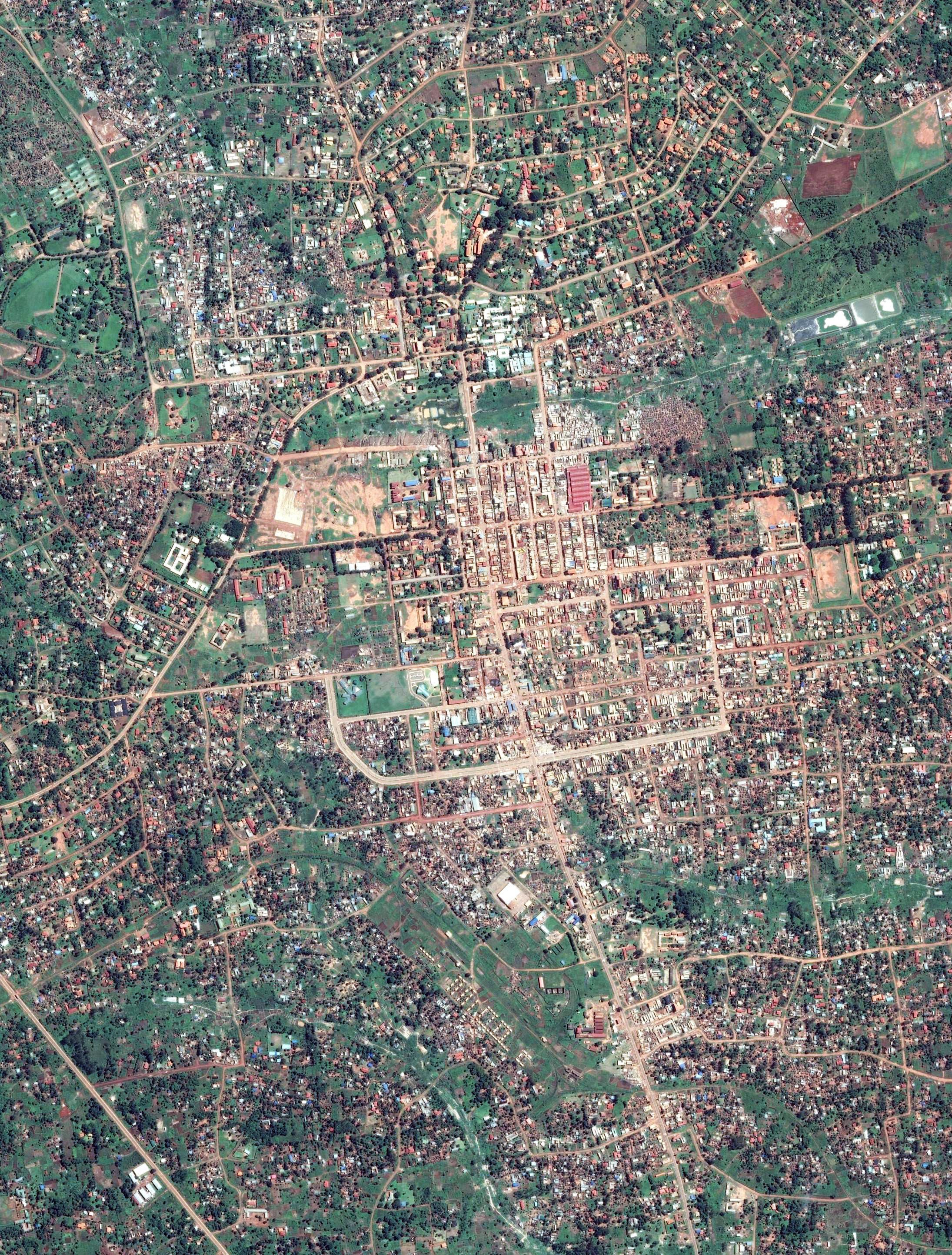
| 5 4 | Urban Planning For The Future Gulu City Urban Planning for the New African ‘Smart City’
Gulu City - Image courtesy of Google Earth, 2019
Gulu In Perspective
Since 2005, governments across the African continent have adopted ambitious new national development plans, framed in terms of structural transformation, through economic take-off.
Over the past decade or so, Richard Vokes argues, the nature of Africa’s development agenda has shifted dramatically. Since 2005, governments across the continent have adopted ambitious new national development plans, which are framed less in terms of ‘anti-poverty’ agendas, and more in terms of structural transformation, through economic take-off. In Uganda’s case, this shift in policy is encapsualted in the Vision 2040 document, launched in 2013. This document outlines a plan for Uganda to achieve middle- income status through the development of such things as: transport and energy infrastructure, manufacturing, and ICT. And it casts the development of the country’s new cities – which are anyway growing rapidly, as a result of demographic pressures – as crucial for achieving all of these things.
The kind of city expansion that is envisioned in Vision 2040 – for both Kampala, and for Uganda’s new cities –
will constitute the third wave of urban development in the country: following the first wave, which occurred as part of the process of colonial integration in the early twentieth century, and the second, which occurred within the post WWII ‘modernisation’ programme. However, the global conditions under which this third wave or urban planning are taking place are very different to those which pertained in the earlier period. In particular, policymakers and urban designers must think very carefully about questions of sustainability, and about the potential benefits and limitations of ‘smart city’ technology, within their plans for future cities.
In his presentation at the Gulu workshop, Alec Thornton put these two key concepts in dialogue, as a means for framing the key questions for the practical co-design workshop that followed. Thornton provided some context on the topic from his own methodological lens in critical urban theory, which established the framework for his discussion based on the
following concepts: rights to the city, the social production of space, and spatial-social justice. He emphasized that smart city ambitions must begin with a dialogue between city officials and its (smart) citizens, to determine the adoption of appropriate technology as a tool to bring equity (fairness) into urban planning that is genuine and sincere in integrating economic, social and environmental needs. However, he also noted that despite decades of research – including within New Urbanism, the Eco-City Movement, and through the concept of Smart Growth – it is still unclear how best to achieve both sustainability and smart growth together. One major issue is that top-down decisionmaking often results in policy-makers becoming attracted to ‘short-term wins’ with ‘black-box’ solutions promoted by hi-tech firms: hence the need for citizens to be engaged much earlier in planning processes.
Katrien Pype’s presentation also looked at the practical problems of achieving technological solutions in urban contexts. Based on her work on technology in Kinshasa, she argued that whole Congolese state and urban authorities are only occasionally initiating technological innovation in the city. NGOs and private entrepreneurs (in particular return migrants) are the main drivers of an emerging tech scene. Kinshasa’s experiences hold key lessons for all African new cities, including Gulu, in suggesting that there are 3 necessities for rendering the ‘smartening’ process more successful: (a) ‘immediate benefits’ for the intended users; (b) ‘trust’ among ‘masters’ and ‘(intended) users’; and (c) local content (in terms of software; applications, etc.). In addition, trust plays a crucial role for the introduction of any new technology. Trust is a crucial element for what Pype descrived as the ‘technology contract’, which is in turn vital for any attempt to ‘smarten up a city’. In relation to Gulu’s case, Pype invited the workshop participants to think about how the complex process of establishing trust much be achieved with residents here (including with those residents who do not have full Ugandan citizenship).
How might new technologies be introduced in Gulu in ways that involve all residents in the process, in ways that make them all equal partners, yet in ways that also draw upon the expert knowledge of urban planners, city authorities, academic researchers, software engineers, and others?



| 7 6 | Urban Planning For The Future Gulu City Gulu In Perspective
Photographs of Gulu City Centre, 2019
Co-design for the Future City

Having posed some key questions for the planning of Gulu City, Dr Julian Bolleter and Dr Anthony Duckworth-Smith from the Australian Urban Design Research Centre (AUDRC) ran two short Co-design activities (Figure 1) as part of the workshop using a specially designed physical open-ended game. The activity was designed to explore and analyse possible options for the future growth of Gulu city and to test the applicability of the serious game method in a new context.
Background
Co-design is a participatory engagement method which seeks to get multiple stakeholders involved in a design process. This can be for the production of services, programmes or objects and places. The aim of Co-design is to facilitate the development of options and solutions which are broadly supported across multiple stakeholder and community groups to give them the best chance of being implemented and maintained/upheld through often lengthy development, delivery and operational phases. In this sense Co-design strives to mitigate the power of
conventional top-down, authoritative approach to design (representative) by incorporating a more unfolding ‘evolving organisation in time and space’ which satisfies multiple users (deliberative).
To achieve this aim methods of Co-design need to meet the following objectives:
• Allow effective contributions from stakeholders – which usually requires education and learning with respect to key concepts and performance measures of the system under scrutiny and also to allow for people to easily input different combinations of parameters to explore and experiment with these concepts and measures.
• Encourage genuine participation – be broadly inclusive, appealing and allow choice as to level of involvement.
• Enable a collaborative approach – foster sharing of ideas and collective reflection as well as building trust amongst often diverse stakeholder groups.
Figure.1: Workshop participants day one, Co-design activity.
The use of games, ‘Serious Gaming’ or ‘Game-based Learning’ is one Co-design methodology which can be used to help achieve these aims and objectives. Games can promote collective reflection (Devisch et al., 2016), group play can promote open communication and therefore contribute to trust building (Laurian, 2009). Both of these are factors which help with learning. Games and play can be very inclusive and appealing as well as offering different levels of involvement, particularly if they are open-ended (Krek, 2008).
Meeting the objective of ‘easily engaging with the parameters of the system under question’ requires game design and development, a process whereby ‘abstract concepts are converted to artefacts (the final game) that generate actual play experiences’ (Larsen, 2018). The design process can be understood, similar to most design challenges in terms of a series of related stages of idea creation (concept), principles of operation (game mechanics), prototyping, critical review and production. Key elements to be considered across these stages include goals, rules, mechanics (scale and modularity), feedback (performance), interactivity (interfaces and tactility), storytelling (context), aesthetics (style, graphic language, colour), polish (style) and feel (haptic and sensory perception).
Therefore whilst the choice of ‘gaming’ and play potentially addresses many of the key objectives of Co-design there is considerable design effort needed to produce the actual physical (or digital) artefact through which interaction takes place to enable these to be met.
AUDRC has designed a serious game ‘Rapid City’ for city region planning and adapted this to help with developing and analysing options for the growth of Gulu city.

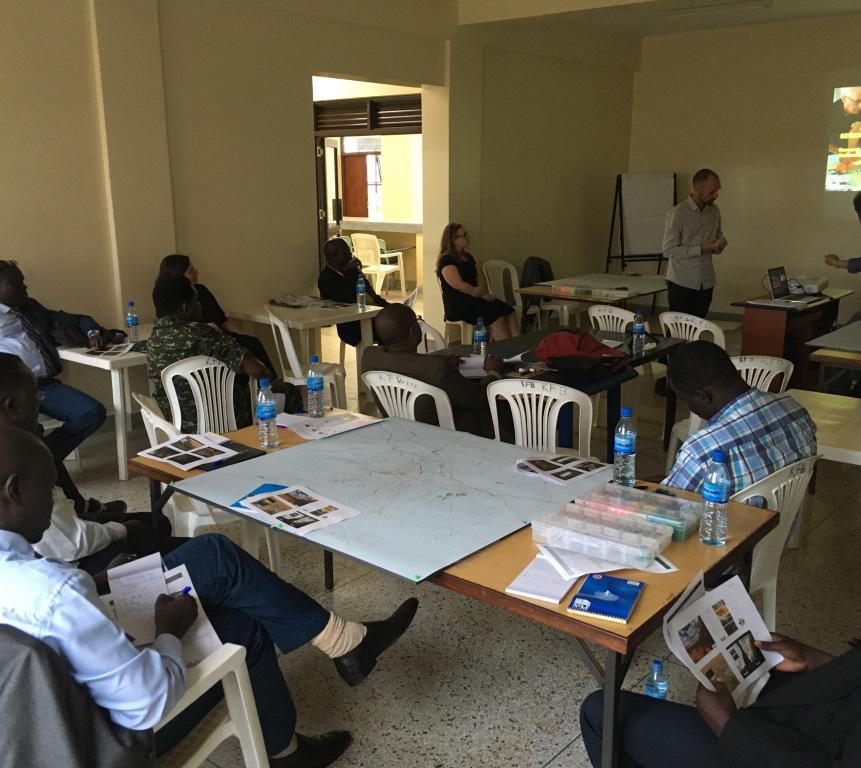

Workshop participants Day 2
Workshop day one, introductions to participants by facilitators
| 9 8 | Urban Planning For The Future Gulu City Co-design for the Future City
Workshop day one, presentation of Co-design methods and ‘Rapid City’ Game.

Game Design & Development
The goal of the game was to generate a collaborative dialogue amongst the participants about possible future growth patterns for the City. It was not intended to produce a plan as such but provide the means for strategic and exploratory thinking about spatial planning and to do this in a collaborative fashion. The goal was therefore openended, there was no ‘winner’ or conclusive termination.
The gameplay was based around groups exploring one of three strategic growth patterns referenced from Richard Forman’s book Urban Ecology: the science of cities (Figure 2). The patterns translated to the Gulu context were:
1. Linear or Corridor - where urban development follows the main movement networks.
2. Satellite Town/Cities – where urban growth occurs and is mostly limited to existing or newly planned urban centres surrounding the urban core area of the city.
3. Dispersed – where urban development follows a more
irregular expansion but could be constrained or take advantage of natural landscape features.
Each group was assigned one of the strategic growth patterns as a starting point. The activity utilised a specially designed interactive model which consisted of a 1m x 1m 1:20,000 scaled base drawing of Gulu and the surrounding region and various physical pieces which could be placed on the base map to represent either Urban Planning Areas, Landmark Functions or Movement Networks. The gameplay progressed through a led activity with a facilitator encouraging participants to initially consider priority growth areas based around the growth pattern. Facilitators would then respond to discussion to place down relevant pieces and/or encourage the participants to do so as a record of the exploratory discussion.
The number of pieces and their design reflected the need to generate some meaningful outcomes at a complex city scale within the limited time of the activity (one to two hours). Urban Planning Areas were represented with seven tiles
Figure 3: Game Pieces Guide Sheet
of various sizes (maximum 3cm x 3cm: 600m x 600m to scale) and also included felt strips for waterways and flags which could be used to record specific ideas. Ten Landmark Functions were represented by pins which could be placed either into the base or into an Urban Planning Area. Different coloured strings were able to be pinned down to represent four different Movement Network types. The model pieces are shown on the guide sheet (Figure 3).
The design of the game pieces reflected the scale of the base plan, the need to easily communicate the three different spatial elements, tactility, appeal, feel and transportability. The base plan was drawn as a real representation of the buildings, key roads and watercourses using available GIS information. These parts of the drawing were carefully represented in terms of visual priority to provide a neutral base from which to project strategic intentions
Preliminary Results



The game activity was run twice with the three groups over two days – six individual group models were completed. On the first day the activity ran for about one and a half hours with each individual group then providing ten to fifteen minutes feedback which was recorded using video. On the second day time was constrained so gameplay was limited to about one hour with feedback.
Participants were generally engaged with the game process as can be seen from the photographic evidence, completion of strategic planning scenarios and willingness to share ideas during the feedback. The goal of the game - to generate a collaborative dialogue amongst the participants about possible future growth patterns for the City - was achieved.
In regard to the specific Co-design objectives:
Allow effective contributions from stakeholders
Participants were able to easily grasp the game design and began identifying locations for pieces relatively quickly. Gameplay flowed from the beginning in most instances. There was one round where the engagement was inhibited early on and this was due to the lack of any group participant having specific detailed knowledge of the city layout. Skilled facilitation was key in ensuring game progression, particularly during the early stages (Figure 4-5)
Levels of education and learning achieved are difficult to measure without follow up or feedback, which does not form

 Figure 4: Corridor development growth scenario Group B, workshop day one
Figure 5: Satellite development growth scenario Group C, workshop day 2
Figure 4: Corridor development growth scenario Group B, workshop day one
Figure 5: Satellite development growth scenario Group C, workshop day 2
Satellite development
Figure 2: The three strategic growth scenarios explored in the Co-design activity. Corridor
development
| 11 10 | Urban Planning For The Future Gulu City Co-design for the Future City
Dispersed
sites development
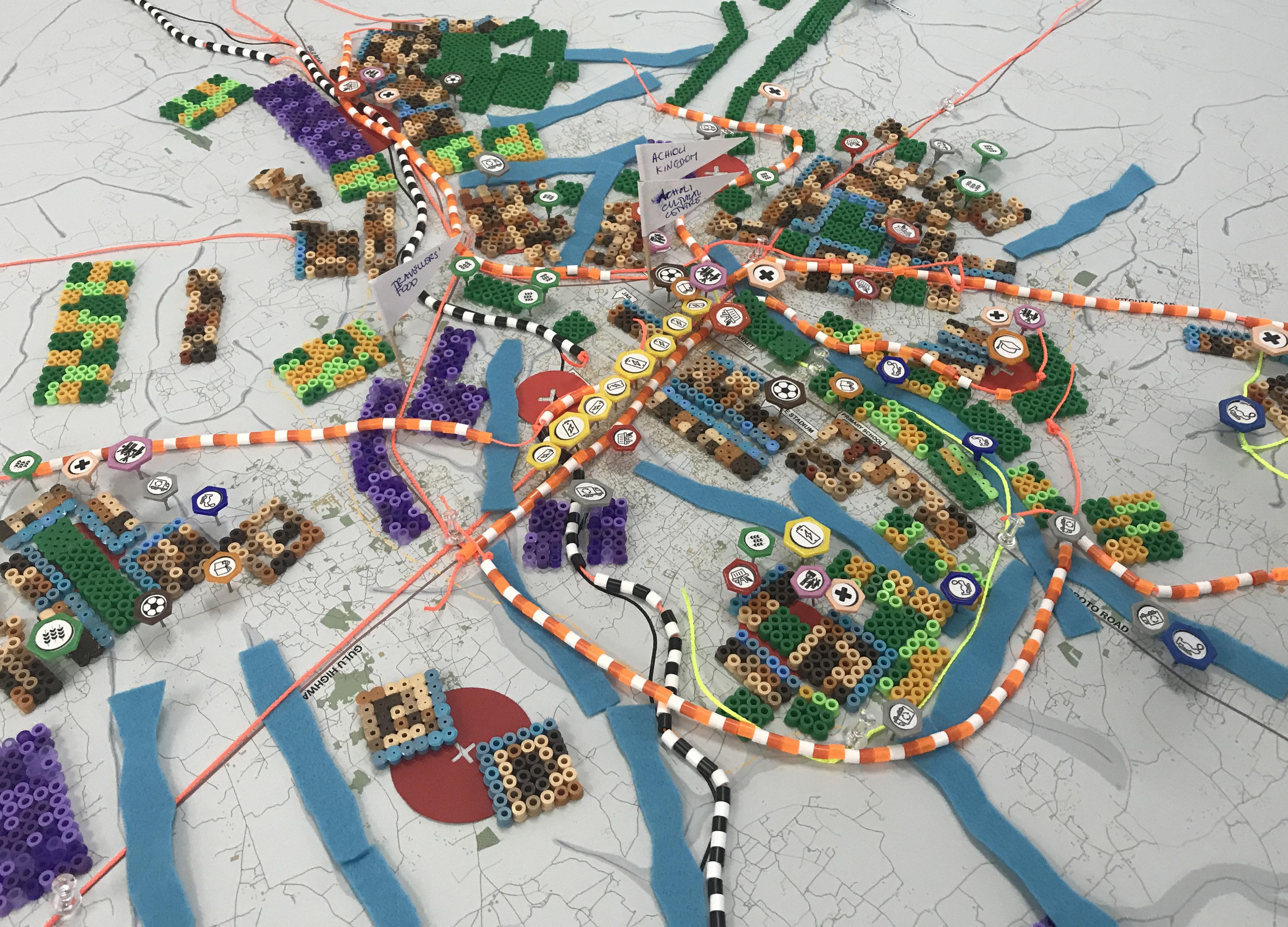
part of this report. Interaction amongst group participants and discussion during the feedback stages demonstrated that new knowledge was being communicated with respect to historical planning and land use, contemporary challenges and future needs. For example participants were able to identify new facilities that were being planned or needed or in some instances and relate stories about cultural settlement patterns. During feedback critique was offered on certain aspects of the growth scenarios, for example planners were able to reflect on the infrastructure cost of a dispersed versus compact settlement pattern.
The game mechanics allowed participants to easily explore and experiment with variations and options to the conceptual growth scenarios. Participants in group A (dispersed) on day one took control of the board after initial facilitation describing their own version of a dispersed settlement pattern. Other groups began to modify the pieces where necessary to describe particular details or specifics of the area (Figure 6). All of the groups produced markedly different responses which indicated an ability
for the facilitated game to sustain experimentation and exploration of different urban growth scenarios (Figure 7).
Encourage genuine participation
The game design was inclusive in the sense that multiple participants were able to take part during the course of play. Players were physically able and most stood whilst engaging although seated play was also possible. Participants were seen to be enjoying the process indicating a high level of appeal. Different levels of involvement were evident as some participants were content to remain informed whereas others moved towards collaborative decision making where they were directly involved in placing game pieces and proposing different options.
Enabling a Collaborative Approach
The physical gameplay clearly demonstrated that ideas were shared not just during the gameplay but also during the feedback sessions. Further analysis will be completed
Figure 6: Detail of completed model - Group C, workshop day one.
of the video footage and audio recording to qualify the types of collaborative and reflective behaviours that were demonstrated. Aspects of lateral and vertical trust building can be difficult to establish from the short individual sessions and without input from individual surveys.
Conclusions and Next Steps
The workshops demonstrated that the methodology of interactive physical play was effective in meeting the overall the aim of the game - to generate a collaborative dialogue amongst the participants about possible future growth patterns for the City. It was also demonstrated to be effective against a number of the specific Co-design objectives. In this sense the application of Serious Games can be seen to be a potentially valuable tool to help investigate the options for the rapid growth of cities in developing areas.
Additional feedback is required to further test the performance of the approach against the Co-design objectives. Also there was limited scope to engage with quantitative analysis although this was discussed. The Urban Planning Area tiles represent a scaled area and could be assigned parameters and therefore key metrics such as population, density, open space provision could feasibly be calculated.
Future applications would benefit from a multi-staged approach:
1. Mapping of existing situation in terms of Urban Planning Areas, Landmark Functions & Movement Networks
2. Visioning and values capture (to potentially inform additional game design elements such as smart city initiatives)
3. Growth scenario game
4. Quantitative and qualitative reporting
5. Post-game participant reflection and feedback
Further refinements could be made to improve the playability and to enable qualitative and quantitative reporting. The overall scale of the base could be reviewed and tested to enable a better integration with the scale of the Urban Planning Areas. The workshop however provided ‘proof of concept’ with respect to the use of a game approach and the general game design for rapid testing of urban growth scenarios of emerging cities.
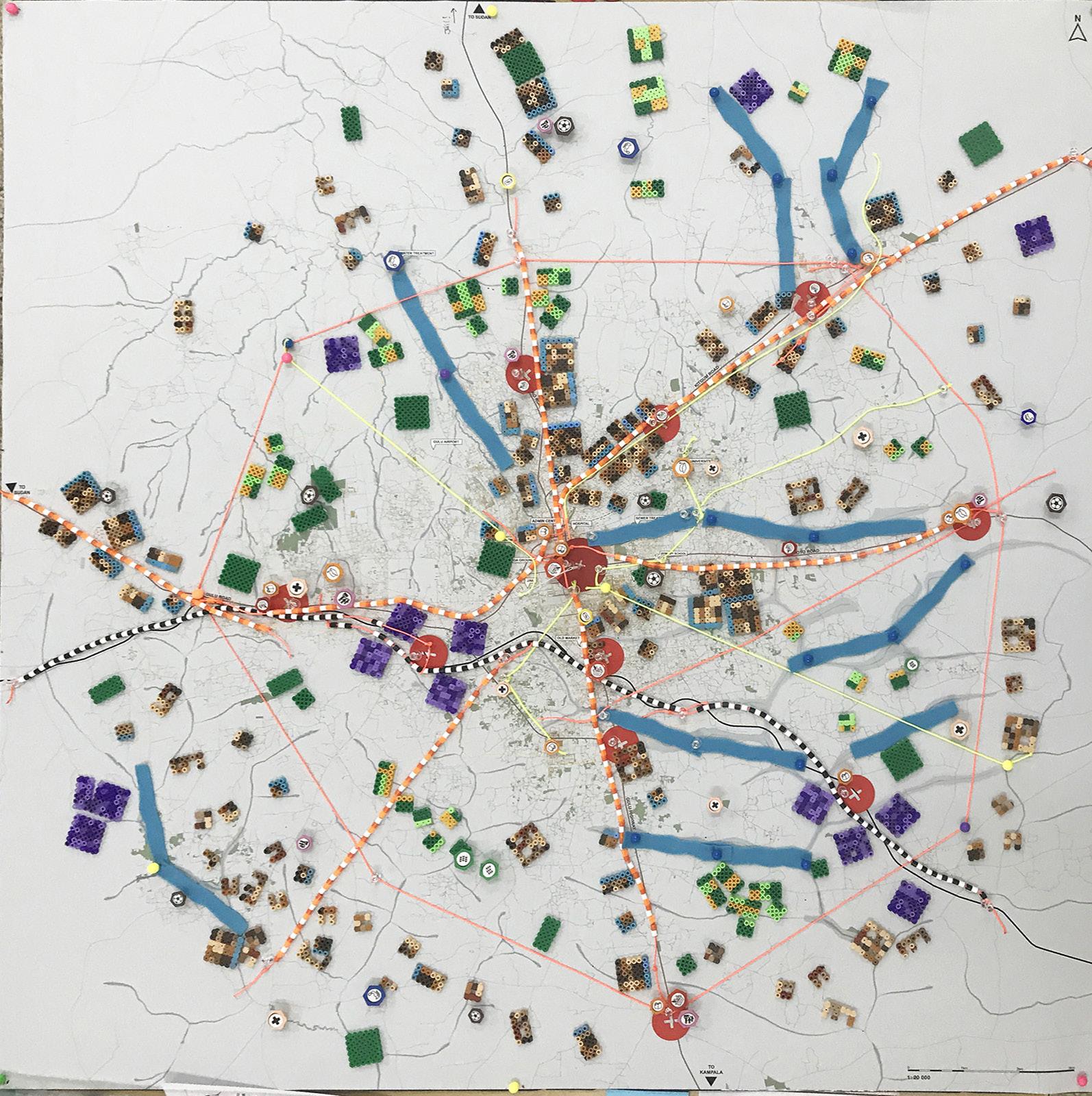

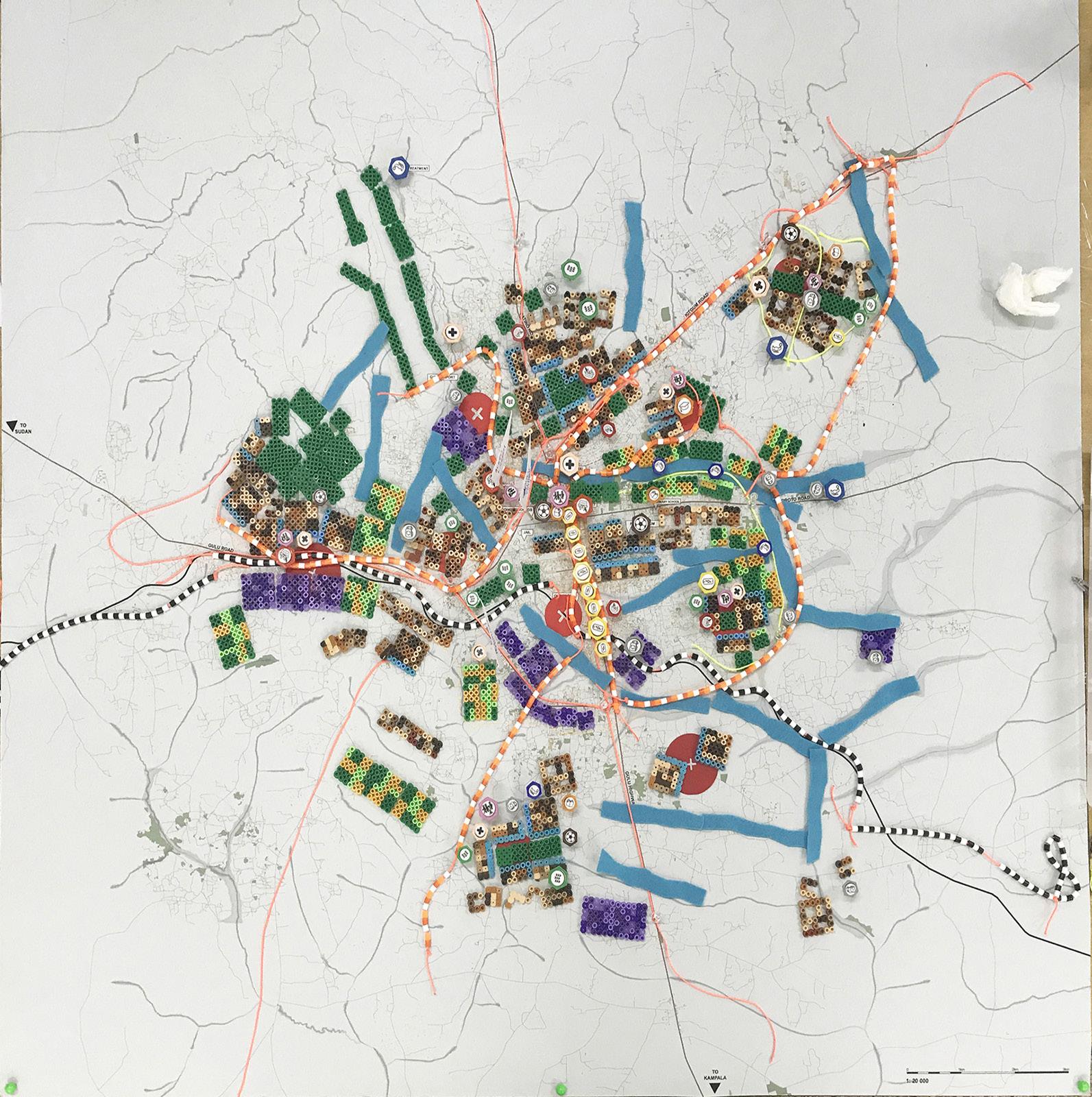
Figure 7: Completed game boards of dispersed(a), corridor(b) and satellite(c) urban growth scenarios, workshop day one.
a b c | 13 12 | Urban Planning For The Future Gulu City Co-design for the Future City
Acknowledgements
We would especially like to thank Prof. G. L. Openjuru, ViceChancellor of Gulu University, for so kindly hosting the workshop ‘Urban Planning For the Future Gulu City’ on 4-5 June 2019.
The authors would also like to thank all of the participants in the workshop, and all those others who helped to organize it: Mr. Moses Abonga (Rep), LC3 Chairperson, Laroo; Brig. Acoka, Co-Ordinator, Operation Wealth Creation, Northern Region; Ms. Betty Alanyo, Librarian II, Gulu University; Mr. Francis Barabanawe, Town Clerk, Gulu Municipal Council; Mr. G. Labeja (Rep), Mayor, Gulu MC; Dr. Simone Zarpelon Leao, Faculty of Built Environment, University of New South Wales; Mr. Tony McBurney, IDGArchtects, Sydney; Mr. Terence Odonga, Municipal Engineer, Gulu Municipal Council; Mr. Alfred Oluba (Rep), LC3 Chairperson, Layibi; Prof. Prem Ramburuth, Institute for Global Development, University of New South Wales; Ms Helen Tanner, Research Assistant University of Western Australia; and Mr. Robert Towler, Fichtner Water and Transportation, GmbH.
We would like to acknowledge the contributions of the University of Western Australia’s Institute of Advanced Studies for their ongoing support.
We would also like to thank Prof. Matthew Tonts, Dean of the Faculty of Arts, Business, Law and Education, UWA; Prof. Benjamin Smith, Associate Dean (Research) of FABLE, UWA, and; all of the funding committee for the FABLE Research Collaboration Awards Scheme, 2019, for their extremely generous funding for the workshop, and for this research project as a whole.



 Figure 9: Detail of completed model - Group C, workshop day one.
Figure 10: Participants engage with the game - Group C, workshop day one
Figure 9: Detail of completed model - Group C, workshop day one.
Figure 10: Participants engage with the game - Group C, workshop day one
| 15 14 | Urban Planning For The Future Gulu City Acknowledgements
Figure 8: Group reflection and feedback - Group A, workshop day two














 Figure 4: Corridor development growth scenario Group B, workshop day one
Figure 5: Satellite development growth scenario Group C, workshop day 2
Figure 4: Corridor development growth scenario Group B, workshop day one
Figure 5: Satellite development growth scenario Group C, workshop day 2







 Figure 9: Detail of completed model - Group C, workshop day one.
Figure 10: Participants engage with the game - Group C, workshop day one
Figure 9: Detail of completed model - Group C, workshop day one.
Figure 10: Participants engage with the game - Group C, workshop day one